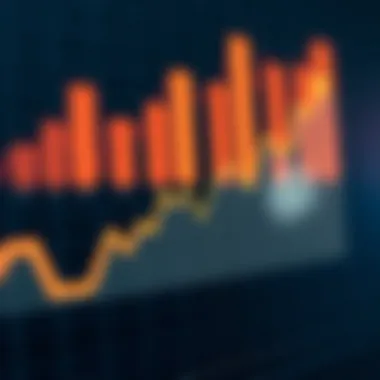Understanding Dollar and Rupee Dynamics: A Deeper Look


Intro
In the ever-shifting world of currencies, the dollar's relationship with the Indian rupee stands out as a matter of great concern for individuals, businesses, and investors alike. Understanding this dynamic is essential because it influences everything from daily purchases to global trade agreements. The fluctuations in dollar prices, particularly against the rupee, tell a broader story about the economic health of nations, their currencies, and the intricate web connecting them to global markets.
Historically, the dollar's value against the rupee has experienced notable ups and downs, shaped by a multitude of factors including inflation rates, interest rates, and economic policies. As the world continues to grapple with the consequences of the COVID-19 pandemic, geopolitical tensions, and evolving market sentiments, the dollar-rupee exchange has become increasingly volatile. For investors and traders, this fluctuation presents both challenges and opportunities worth exploring.
This article seeks to dissect the underlying components affecting the dollar's price in rupees, market trends, investment strategies, and even how these factors permeate into the realm of cryptocurrencies. Whether you're an investor keeping a keen eye on foreign exchange trends or an analyst examining economic indicators, this overview aims to provide you with a thorough grasp of the components at play. Let's delve deeper into the market analysis to better understand these complexities.
Preamble to Currency Exchange
Understanding the dynamics of currency exchange is crucial in today’s interconnected economy. The relationship between the dollar and the Indian rupee serves as a prime example of how currencies can influence national landscapes and personal decisions alike. Currency exchange directly impacts trade, investments, and even tourism; thus, grasping its nuances can equip investors, traders, analysts, and educators with invaluable insights into market behavior.
When talking about currency exchange, it’s easy to get lost in the nitty-gritty details of complex financial systems. But at its core, currency exchange is about so much more than just numbers on a screen. It’s about how economies interact, how wealth flows between nations, and how individual lives can be affected by fluctuations in exchange rates. A strong rupee can make imports cheaper, while a weak one can make exports more competitive.
In a country like India, where the rupee’s performance against the dollar can significantly impact economic conditions, understanding these exchanges is doubly important. Investors find themselves considering the effects of currency fluctuations on potential returns from investments abroad, while businesses must navigate these waters for pricing imports and exports strategically. This section will shed light on the factors that underpin these relationships, painting a more complete picture of currency exchange's significance.
Understanding Currency Value
Currency value isn't just a number; it reflects the health of an economy. It’s shaped by various factors such as inflation rates, interest rates, and overall economic stability. When we talk about the value of the rupee against the dollar, we implicitly discuss the economic conditions within both countries. In simple terms, a strong dollar might suggest a robust economy in the U.S. while indicating economic challenges in India if the rupee weakens.
How do we gauge this value? The exchange rate is a primary metric. It indicates how much of one currency you need to exchange for another. The exchange rate can fluctuate due to changes in economic indicators, making it essential for stakeholders to keep their fingers on the pulse of financial news. For instance, when the Federal Reserve raises interest rates, the dollar often strengthens; this potentially makes life harder for the rupee.
This relationship is also visible in terms of purchasing power. If the dollar is strong, it could purchase more goods and services compared to a weak rupee, altering spending behaviors. All these intricacies imply that understanding currency value requires more than just knowing the latest exchange rate—it involves a broader awareness of economic factors that contribute to it.
The Role of Exchange Rates
Exchange rates are not just mere numbers; they are the lifeblood of international trade. A nation's exchange rate affects its balance of payments, which reflects how much it spends abroad versus what it earns from foreign transactions. When the dollar appreciates against the rupee, Indian exports may become more expensive for international buyers, putting a pinch on domestic businesses.
Conversely, a stronger rupee can allow Indian consumers to import goods more affordably, affecting the competitive landscape for local producers. Thus, exchange rates have direct implications not only for macroeconomic indicators like GDP growth but also on the daily lives of individuals. For instance, travelers heading abroad will find that their money will stretch further or shorter depending on these rates.
Moreover, the fluctuations in exchange rates can lead to uncertainties that investors often find challenging to navigate. The risk of sudden depreciation can deter foreign investment. Therefore, policymakers must pay close attention to exchange rates and, in some cases, implement measures to stabilize them.
Ultimately, the role of exchange rates is profound and multifaceted. They influence economic relationships and financial strategies while offering windows into the general economic climate of a country. This knowledge equips stakeholders—be it investors, traders, or educators—with the tools necessary to make informed decisions in an ever-fluctuating landscape.
"A stable exchange rate is essential for fostering long-term trade relationships and ensuring economic growth."
Understanding how exchange rates function offers valuable insights into predicting market trends and making strategic financial decisions.
Historical Context of Dollar and Rupee
Understanding the historical context of the dollar and rupee exchange rate is crucial for grasping the dynamics of today’s currency market. The volatility of this exchange rate can be traced through various economic shifts, global events, and policy changes that have occurred over the decades. Recognizing these historical trends sheds light not only on the current pricing but also provides a framework for anticipating future fluctuations.
Evolution Over the Decades
The dollar and rupee have traveled a long and winding road together. The relationship began taking form after India gained independence in 1947. Initially, the rupee was pegged to the British pound, and the dollar's value was significantly higher in comparison. However, in 1971, a pivotal shift occurred: the world moved away from the Bretton Woods system, allowing currencies to float. This change opened the floodgates for fluctuations based on market demand and economic conditions.
Through the 1980s and 90s, the Indian economy was characterized by protectionist policies which kept the rupee artificially high compared to the dollar. But the tide changed post-1991 when India faced a balance of payments crisis, leading to economic liberalization. The liberalization policy encouraged investments, and the rupee gradually adopted a more market-driven approach.
Since then, the value of the dollar in rupees has seen sharp rises and falls, affected by various factors, including geopolitical events, oil prices, and domestic economic policies. Key moments included the global financial crisis of 2008, which saw the rupee drop as investors fled to safe havens like the US dollar, and the recovery that followed when India climbed back into the investor's favor.
Major Economic Events
Pinpointing major economic events that influenced the dollar-rupee exchange provides a clearer picture of their connection. Among the significant occurrences:
- Economic Liberalization (1991): Initiatives to open up the Indian market significantly affected exchange rates, allowing the rupee to reflect its true market value against the dollar.
- Dot-Com Bubble Burst (2000): This resulted in massive investment outflows from emerging markets, including India, putting pressure on the rupee.
- Global Financial Crisis (2008): The ensuing economic turmoil sent the rupee plummeting to record lows against the dollar, emphasizing the interlinkage between global finance and local currency.
- Demonetization (2016): Though primarily aimed at curbing corruption, the sudden withdrawal of currency denominations temporarily disrupted economic activity and showcased how domestic policies can sway currency value.
- COVID-19 Pandemic (2020): As economic activities slowed, currencies fluctuated with uncertainty. The rupee faced depreciation due to global economic slowdown, leading to an active interest in understanding these dynamics.
“The historical trajectories of currencies not only reflect economic policies but also the pulse of a nation’s journey.”


In summary, the evolution of the dollar and rupee is a complex narrative crafted over decades. From restrictive economic policies to bouts of liberalization, the international landscape has shaped the fluctuating dance of these two currencies. As we move forward, keeping an eye on the past helps us comprehend the present and project potential futures in currency exchange.
Factors Influencing Dollar Price in Rupees
Understanding the various factors influencing the dollar price in rupees is crucial for investors, traders, and anyone else hoping to navigate the complexities of the foreign exchange market. Exchange rates do not merely reflect market mechanics; they embody the economic pulse of nations, revealing insights about inflation, interest rates, trade balances, and geopolitical contexts.
The connection between these elements can be intricate, yet it is this very complexity that makes it essential to study them. As dollar prices fluctuate in relation to the rupee, the effects ripple through the broader economy. A rise in the dollar can lead to higher import costs, influencing inflation rates, while shifts in interest rates can have profound impacts on investment decisions across sectors. Consequently, delving into these factors offers insights not just into currency valuation, but also into economic health and market sentiment.
Inflation Rates
Inflation serves as a critical variable when examining dollar pricing against the rupee. As domestic inflation rises in India, the purchasing power of the rupee declines, forcing the currency's value lower—thereby elevating the dollar price. Conversely, if inflation is stable or declining, the rupee can strengthen, making it preferable for dollar pricing to fall.
The Reserve Bank of India, for instance, closely monitors inflation rates and adjusts monetary policies consequently. If inflation spikes, as seen during periods of economic distress or supply chain disruptions, the RBI might increase interest rates to curb inflationary pressures. This balancing act can lead to a direct response in the exchange rate, exemplifying how inflation can create a seesaw effect on currency values.
"Inflation does not just affect prices; it shapes perceptions, influences monetary policy, and ultimately, determines currency strength."
Interest Rates and Monetary Policy
Interest rates represent another pivotal factor influencing dollar pricing in rupees. They set the terms on which money is borrowed and lent, affecting investment decisions across the board. When interest rates in the United States rise, for instance, international investors may flock to invest in U.S. securities, attracted by higher returns. Consequently, demand for dollars surges, increasing its price in rupees. Similarly, if India raises its interest rates, it might strengthen the rupee versus the dollar, making Indian assets more appealing.
It’s worth noting that the interplay between government policies and market reactions can trigger swift adjustments in currency valuations. Central banks utilize various tools within their monetary policy frameworks to respond to economic changes. A delicate balancing act begins—too high rates could stifle growth, too low could lead to inflation; both scenarios impact currency strength in multiple ways.
Trade Balance Impacts
The trade balance—the difference between a country’s exports and imports—directly impacts the demand for currencies. A trade deficit, where imports exceed exports, means that more foreign currency is needed to settle transactions. This can lead to increased demand for dollars and, consequently, a rise in dollar prices relative to rupees. Conversely, a trade surplus means higher demand for the rupee as foreign buyers purchase Indian goods, potentially lowering the dollar's value in rupees.
For instance, during strong export periods for India, the rupee tends to appreciate as foreign currency floods in, lowering the dollar’s price. Observing trends in trade data can thus provide valuable insights into predicting currency movements.
Geopolitical Influences
Geopolitical circumstances can sway currency prices in a heartbeat. Conflicts, diplomatic relations, and international trade agreements shape perceptions and momentum. A stable political climate generally favors currency appreciation, while uncertainty can lead to depreciation.
For example, economic sanctions imposed on a nation can lead to inflation and decreased trade, negatively influencing currency values. Similarly, in India, tensions with neighbors or shifts in foreign policy can create a ripple effect that impacts the rupee’s strength against the dollar. Understanding these geopolitical contexts enriches the analysis of currency trends, as it dives deeper into the larger narrative behind currency fluctuations.
Current Trends in Dollar to Rupee Exchange
The dynamics of the dollar to rupee exchange rate are an integral part of understanding the Indian economy and its position in the global market. As the dollar strengthens, the rupee tends to weaken, and this simple relationship has extensive implications. Importers, exporters, investors, and everyday consumers alike feel the ripple effects of these fluctuations.
One key factor to consider is how recent dollar price movements directly affect the cost of goods and services in India. A stronger dollar can lead to increased prices for imported products, pushing inflation higher and affecting purchasing power. Moreover, the intrinsic connection between exchange rates and economic policies makes current trends vital for strategic planning in various sectors.
Recent Movements
The recent movements in the dollar to rupee exchange illustrate the volatility of currency markets influenced by a multitude of external factors. Over the past few months, we’ve observed significant fluctuations. For example, early 2023 saw the rupee depreciate to around 82 rupees per dollar amid rising inflation in the United States and geopolitical tensions. Conversely, signs of stability in U.S. monetary policies may have led to a slight appreciation of the rupee against the dollar, hovering around 79.50 rupees later in the year.
- Key aspects of recent movements include:
- Central bank actions – Both the Reserve Bank of India and the U.S. Federal Reserve play pivotal roles in shaping interest rates and, thus, influence currency movements.
- Market speculation – Traders often react to news, causing short-term volatility. Investors watch for cues from geopolitical events or changes in domestic policy that can shift market sentiment rapidly.
- Economic indicators – Regular releases of data such as GDP growth, employment rates, and trade balances fuel the market’s perception of the currency’s strength or weakness.
Market Sentiment Analysis
An analysis of market sentiment towards the dollar and rupee exchange rate can prove invaluable for investors and businesses. Sentiment reflects broader attitudes towards economic prospects and can shift dramatically based on news cycles or unexpected events. For instance, emerging economic trends—like a potential recession in the U.S.—might lead investors to seek refuge in the dollar, causing its value to rise relative to the rupee.
Elements shaping this sentiment include:
- Economic forecasts from credible institutions often influence traders’ behavior. When reputable analysts predict a downturn in the U.S. economy, confidence in the dollar can waver, boosting the rupee.
- Global events, such as conflicts or trade sanctions, alter perceptions. The recent tensions in Eastern Europe, for instance, have ramifications on oil prices and currency valuations, caught in a web of global economic interdependencies.
- Psychological factors cannot be discounted. Speculation and herd behavior can create significant market swings, sending investors into a buying frenzy or lead to panic selling.
In this context, understanding market sentiment is crucial for formulating effective investment strategies.
A keen awareness of currency trends enables investors to anticipate shifts and adapt their strategies accordingly.


By observing these factors with a discerning eye, analysts, traders, and investors can glean useful insights.
As we move forward, these trends will continue to play a critical role in determining the future trajectory of the dollar to rupee exchange, essentially shaping the landscape of international trade and investment.
Impact on Indian Economy
The interplay between the dollar's price and the Indian rupee is more than just numbers on a screen; it carries significant weight for the broader Indian economy. The fluctuations in this exchange rate can ripple through various sectors, impacting everything from consumer prices to the viability of exporting businesses.
Effects on Inflation
When the dollar strengthens against the rupee, it can lead to higher costs for imported goods, thereby stoking inflation. As imported products become more expensive, manufacturers and retailers typically pass on those costs to consumers. This can mean higher prices at the grocery store or for electronics. Fundamentally, when people feel the pinch in their wallets, overall spending tends to decrease, acting as a dampener on economic growth. Moreover, the Reserve Bank of India may raise interest rates to curb inflation, creating a delicate balancing act that policymakers must navigate.
- Imported Goods: Everyday products like oil, machinery, and electronics significantly impact the inflation rate.
- Consumer Behavior: If prices keep rising, consumers tighten their belts, leading to decreased demand which can hurt local businesses.
- Interest Rates Response: A rising inflation rate might compel the central bank to increase interest rates, which can slow down investments and spending.
Influence on Imports and Exports
A fluctuating dollar value doesn’t just affect inflation; it also pulls at the threads of India's trade balance. When the rupee weakens, Indian exports can become more competitive in international markets, making goods produced in India cheaper for foreign buyers. However, this isn’t a one-size-fits-all scenario. Some industries, like textiles or IT services, could reap the benefits of a weaker rupee, while others that rely heavily on imported raw materials or technology might find themselves struggling.
- Exports Boost: A favorable exchange rate makes Indian products more sought after, potentially increasing export volumes.
- Import Strain: Businesses that depend on imported goods may face increased production costs which can lead to reduced profit margins. This can sometimes force companies to relocate or even shut down.
- Trade Balance: The overall effect on the trade balance can be nuanced. While exports may rise, increased import costs could worsen the trade deficit, leaving policymakers to ponder the long-term sustainability of such gains.
Investment Climate
The dollar's strength has a determining impact on India's investment appeal, both for foreign direct investment and local investors. A stable exchange rate might attract more international investors looking to set up shop in India, while drastic fluctuations could raise concerns.
- Foreign Investments: If the dollar depreciates against the rupee, it may deter foreign investments as returns diminish for foreign investors.
- Domestic Investments: On the flip side, a stronger rupee can provide some stability, allowing Indian businesses to invest in growth without hedging against potential losses from currency fluctuations.
- Stock Market Volatility: Investors often watch currency trends as an indicator of economic stability. A weakening rupee might signal trouble, leading to volatility in the stock market as investors reassess their portfolios.
In closing, the impact of dollar pricing on the Indian economy is multi-faceted, with implications stretching far and wide. It’s crucial for policymakers, businesses, and investors alike to stay tuned into these fluctuations and understand their potential impact, keeping one eye on the present while forecasting for the future.
Strategies for Investors and Traders
In the complex world of currency exchanges, having robust strategies is essential for investors and traders alike. The fluctuations in dollar prices against the rupee can create both opportunities and risks. For individuals looking to navigate this landscape effectively, it's crucial to understand the various approaches one can adopt. This section focuses on critical elements such as hedging risks, adjusting trading strategies, and effectively analyzing market conditions.
Hedging Risks with Currency Derivatives
Risk management is fundamental in trading, particularly in currencies that experience frequent fluctuations. Hedging with currency derivatives offers a practical way to mitigate possible losses due to adverse movements in exchange rates. Currency derivatives can take various forms—options, futures, and swaps being the most notable.
For an investor, these instruments allow one to lock in exchange rates for future transactions. Say, for instance, you expect to make a purchase of goods priced in dollars, and current rates are favorable. You might use a currency forward contract to hedge against risk, ensuring your purchase cost remains fixed, regardless of market fluctuations at the time of transaction.
It's worth noting that not all hedging methods are perfect. Choosing the right derivative involves understanding underlying costs, market dynamics, and your own risk tolerance. Moreover, the complexity of these instruments might not suit every investor. Therefore, assessing whether to engage in heavier or lighter hedging is crucial for aligning strategy with financial goals.
"Effective hedging can be the difference between a profitable trade and a financial setback. Understanding the tools available shapes informed decision-making as much as the currency itself."
Adapting Trading Strategies
The currency market is like a chameleon, constantly shifting and adapting. For investors and traders, the ability to modify strategies in response to changing market conditions is essential. An adaptive strategy can range from adopting different trading styles—like day trading, swing trading, or position trading—to employing technical and fundamental analysis to make informed decisions.
You need to keep an eye on macroeconomic indicators that can affect the dollar-rupee exchange rate, such as inflation reports, employment data, and Federal Reserve interest rate changes. Besides, analyzing trends and patterns in past currency movements can provide invaluable insights.
Additionally, traders should consider sentiment analysis, which gauges market mood. Tools like sentiment indicators can help predict movements based on collective trader behavior, which often exhibits predictive signals. In an unpredictable market, emotional reactions can cause mispricings and present serendipitous opportunities.
To sum up, the best traders remain flexible. Sticking rigidly to one strategy can lead to missed opportunities or worse, substantial losses. This market requires a mindset open to ongoing learning and adjustment, ensuring that approaches remain relevant amid currents of change.
By incorporating these strategies, both seasoned investors and newcomers can better navigate the fluctuating landscape of the dollar against the rupee, positioning themselves to capitalize on market dynamics.
The Relationship Between Currency and Cryptocurrency
In today’s financial landscape, the interplay between traditional currencies, like the Indian rupee and the dollar, and the burgeoning realm of cryptocurrencies has become essential for investors and traders alike. Understanding this relationship can influence investment strategies and promote informed decision-making within the realm of both currencies and digital assets.


The discussion around this relationship is not just academic; it impacts real-world economic behaviors, investment outcomes, and portfolio management. Recognizing how fluctuations in dollar pricing can spill over into the crypto market provides a substantial edge for stakeholders who wish to navigate these interwoven worlds effectively.
Dollar Fluctuations Affecting Crypto Investments
When the dollar takes a nosedive or surges against currencies like the rupee, it creates ripples across the investment spectrum, including cryptocurrencies. A stronger dollar generally indicates that more investors are retreating into safer assets, possibly leading to a decline in the allure of volatile assets such as Bitcoin and Ether.
Consider this: if the dollar strengthens significantly while the rupee suffers, investors might be less inclined to invest in crypto assets priced in rupees. This is largely because their local purchasing power is diminished. Moreover, the base pairing in exchanges plays an important role too; for instance, if Bitcoin is trading at a higher price in dollars, its price in rupees will naturally reflect these changes, complicating the landscape for traders.
"Understanding dollar movements is crucial, as it can be the difference between a lucrative investment and a missed opportunity in the crypto sector."
One must also ponder over the psychological aspect. When dollar values fluctuate wildly, it can lead to market sentiment swings that further affect crypto investments. Traders watching the currency markets closely may decide to move funds from fiat to cryptocurrency or vice versa based on short-term perceptions of stability or risk.
The Role of Stablecoins
Stablecoins emerge as a unique bridge between fiat currencies and cryptocurrencies, designed to offer the best of both worlds. These digital currencies are pegged to traditional currencies, such as the US dollar, making them less volatile than other cryptocurrencies. For individuals and institutions looking to manage their exposure to dollar fluctuations, stablecoins provide a safety net, allowing for transactions and savings that bear less risk than typical cryptocurrencies.
The popularity of stablecoins can be attributed to their inherent ability to combine the liquidity and speed of cryptocurrencies with the stability of traditional fiat currencies. They provide an avenue for investors to park their dollars without the constant fluctuations that Bitcoin or Ethereum may present. This relationship becomes particularly important during times of economic uncertainty, where investors look for stability.
Some notable examples include Tether (USDT) and USD Coin (USDC), which are widely used for trading on various exchanges. Their utility as a means to facilitate transactions while mitigating risks associated with dollar fluctuations makes them attractive for both individual and institutional investors.
Future Considerations for Dollar and Rupee
The interplay between the dollar and the Indian rupee is a topic of critical importance for anyone invested in markets. Understanding future considerations surrounding this exchange rate can greatly inform investment strategies, trading decisions, and economic forecasts. Countless individuals and institutions are affected by shifts in these values every day. This section aims to unpack elements that shape future expectations, their benefits, and the important factors to keep in mind.
Forecasting Exchange Rates
The value of the dollar against the rupee fluctuates based on a myriad of factors, from economic indicators to geopolitical tensions. Forecasting these rates requires not only analyzing historic trends but also having an eye on current dynamics. Investors often utilize methods like statistical modeling, which can encompass techniques such as regression analysis or ARIMA models.
For instance, observing macroeconomic data like GDP growth rates, inflation indices, and employment figures can provide clues on where exchange rates may head. Keeping an eye on Reserve Bank of India's monetary policy announcements can tell a lot about possible currency movements.
Additionally, market sentiment plays a role. Interest from foreign investors, along with their perception of the Indian economy’s health, can shift demand for rupees, ultimately impacting exchange rates. Using tools such as Forex trading platforms to track real-time movements can also aid in making informed predictions.
Long-Term Economic Outlook
Looking ahead, the long-term economic outlook for the rupee relative to the dollar presents both challenges and opportunities. India's position as a rapidly growing economy suggests potential strength for the rupee, assuming that structural reforms continue and the country maintains strong diplomatic ties. However, sustained vulnerabilities exist, particularly given dependency on oil imports and global market conditions.
Considerations investors may want to keep in mind include:
- The impact of inflation on purchasing power and currency valuation.
- Global economic slowdowns, which might lead to reduced demand for exports and thus affect the rupee.
- Policy changes from the Indian government or international monetary authorities that could alter economic trajectories.
In summary, the foresight into future dollar-to-rupee exchange rates involves grappling with uncertain yet significant variables. Both investors and financial analysts should keep abreast of current events and fundamental shifts to better position themselves within an ever-changing economic landscape. As the markets evolve, so too should the strategies and outlook for those engaged in currency exchange and investments.
Culmination
As we bring our exploration of the dollar's fluctuating price in rupees to a close, it’s crucial to underscore the multifaceted nature of this topic. The dollar-to-rupee exchange rate isn’t merely a financial figure; it represents a living aspect of economic interplay that influences a spectrum of activities within India and abroad. Understanding this dynamic can offer significant advantages for diverse stakeholders, from everyday consumers to seasoned investors.
Summarizing Key Insights
In our previous sections, we delved into several key elements:
- Historical Context: The relationship between the dollar and rupee has evolved, shaped by historical events and economic policies.
- Influencing Factors: A myriad of forces, including inflation, interest rates, and geopolitical tensions, play an integral role in determining exchange rates.
- Current Trends and Economic Impact: Recent movements in the forex market have significant implications for inflation and the broader Indian economy. It's clear that as the dollar strengthens or weakens, the ripple effects can be profound and far-reaching.
- Future Considerations: Speculations regarding exchange rate forecasts are complicated by the unpredictability of global economic trends and national policies.
In summary, keeping a finger on the pulse of dollar fluctuations provides not just insights but equips players in the market with the foresight needed for informed decision-making.
The Importance of Staying Informed
In an age where information is abundant yet often muddied, staying well-informed is not just beneficial—it’s vital. For investors and traders, knowledge about currency fluctuations allows for prudent strategies that can mitigate risks. Individuals planning for international travel or studying abroad need to track exchange rates, as these figures can impact personal finances.
The complexity of the dollar's interaction with the rupee indicates that fluctuations can arise from seemingly distant economic or political events. Knowing where to find reliable and accurate updates—be it through government financial reports, reputable news sites, or economic analysis platforms—can vastly improve one’s financial literacy and ability to navigate the marketplace.
By synthesizing the insights gathered throughout this article, it becomes apparent that understanding the landscape of dollar prices against the rupee is not only essential for specific financial strategies but is also indispensable for grasping the larger economic currents that shape global finance.
"In a rapidly changing world, knowledge is the one currency that never loses value." — Unknown
Whether you are a trader who works the markets or simply someone who wishes to be better prepared for future financial endeavors, staying on the ball with currency valuation is a practice worth cultivating. The implications of these fluctuations extend beyond mere numbers; they weave into the very fabric of economic stability and growth.















